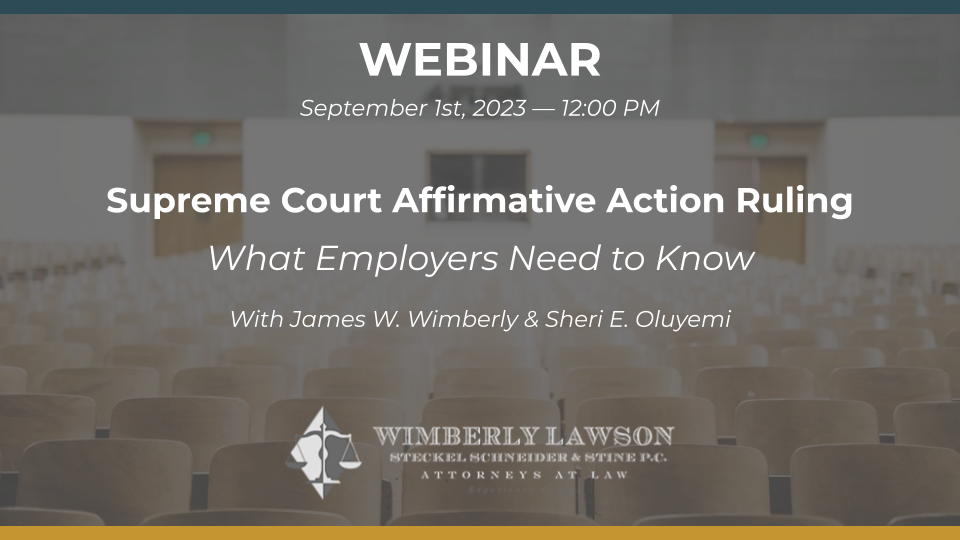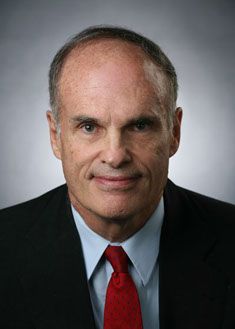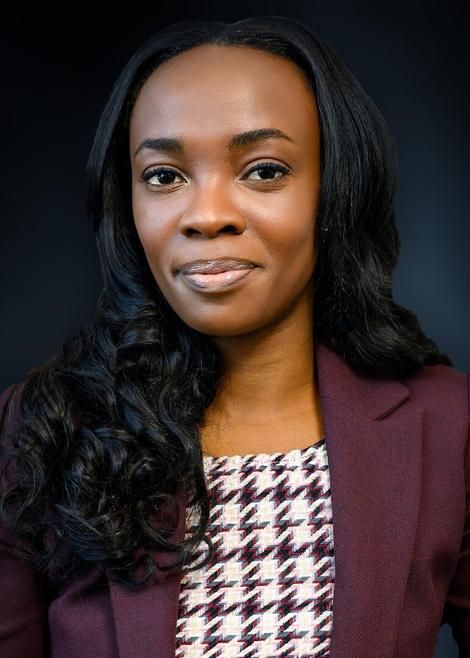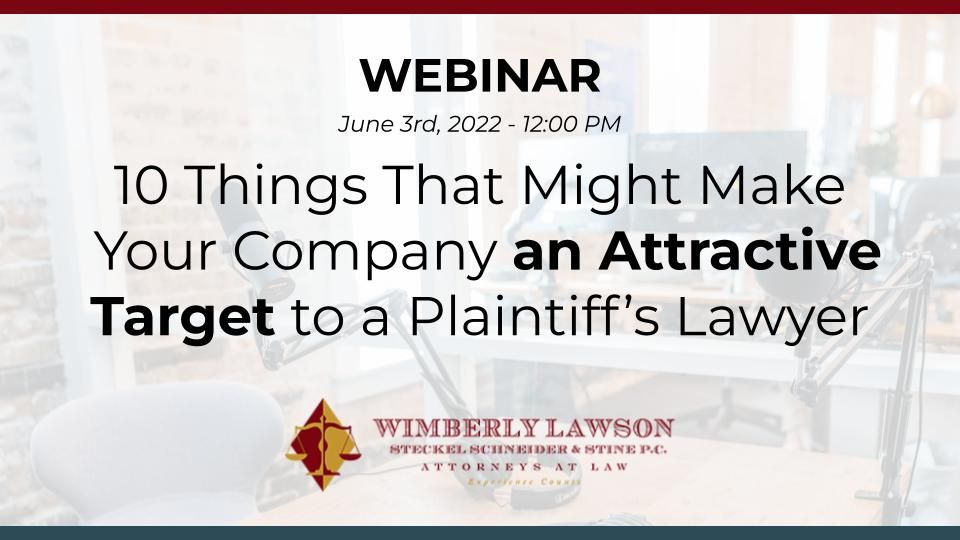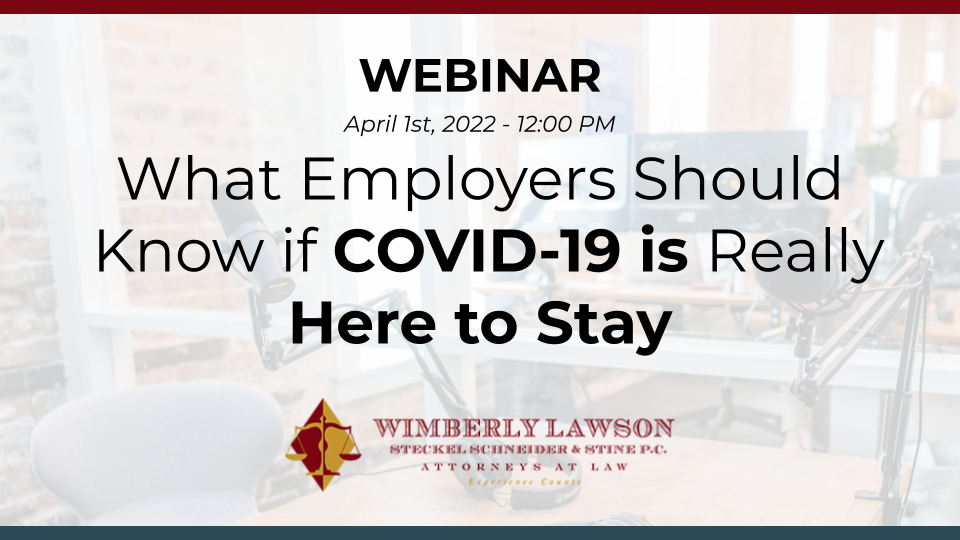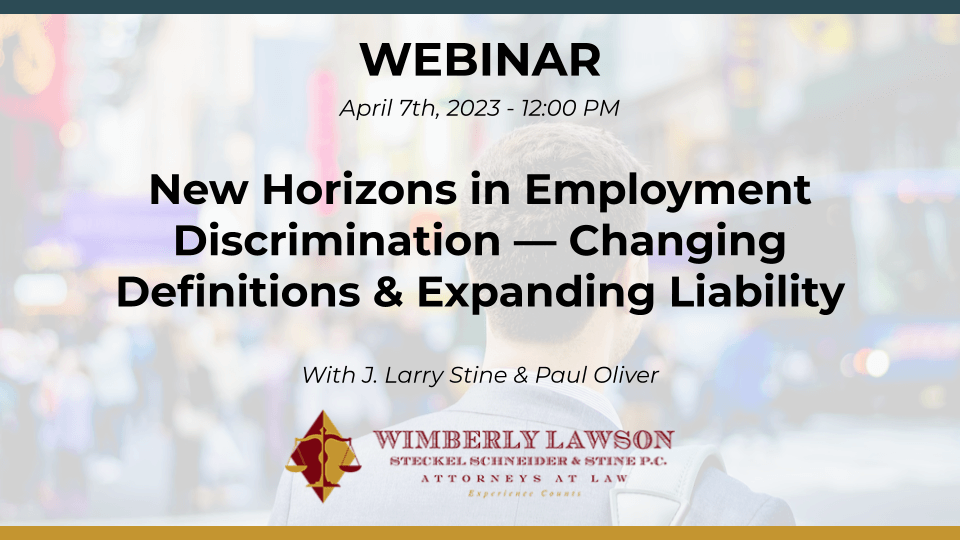
Supreme Court Affirmative Action Ruling: What Employers Need to Know
Some find the US Supreme Court ruling on affirmative action in the Harvard/UNC case controversial, while others see it as a straightforward application of federal law. Most experts agree that it will have some effect on diversity, equity, and inclusion (DEI) programs, particularly if those programs go “too far” in light of the Supreme Court ruling. On the other hand, most believe, including the Biden Administration, that current policies can be adjusted to sustain the goal of equal opportunity. This webinar addresses issues and questions including:
- Aspects of AAP programs most likely to be legally attacked,
- What steps employers can take to modify existing AAP programs to remain supportive of EEO goals but not in violation of the law,
- How will EEO training programs be affected, and
- How can an employer introduce modifications to affirmative action programs with both legal requirements and employment community expectations in mind?
Watch This Webinar
Webinar Transcript
Sheri E. Oluyemi (00:01):
Good afternoon, everyone. Welcome to our monthly webinar on all things employment law here at Wimberly Lawson. My name is Sherry, I am Opun here at the firm. And with me, I have our founding equity senior partner, Jim Wimberley. I, as I said, am op council with the firm. Been with the firm now going on three years. I practice exclusively employment, law management, defense, as well as the plaintiff pace here or there. Jim <inaudible>, would you like to introduce yourself a little bit more?
James W. Wimberly (00:35):
No, except I'm excited to be here and I think we're gonna discuss something that's of growing interest.
Sheri E. Oluyemi (00:43):
Exactly. Today we're talking about the Supreme Court case in the U N C and Harvard case. So this is students for fair admissions birth of U N C and students for fair Admissions versus Harvard. And we'd like to let you know what employers need to know as a result of the Supreme Court's decision in these two consolidated cases. So I'll just start off by giving our audience here a bit of an overview about the cases, what was decided, why do we care? After the overview three, we'll have a q a session style webinar where I will moderate, I'll ask questions and he'll give us his knowledge on these topics. At the very end, you'll have an opportunity to ask questions. We'll save at least 10 minutes for questions. In order to ask your question, you can either raise your hand, just use the icon at the bottom of your screen, it looks like a little palm.
Sheri E. Oluyemi (01:38):
Click that button and I'll give you the floor. We'll all be able to hear your question, or you can type your question into the chat. If you type your question into the chat, I'll review it and I can read that out and we'll do our best to answer your question. So that's just the housekeeping regards to question in answer. I'll also just say, our standard disclaimers is not legal advice. You if you have specific issues, specific questions, you should always consult an attorney. And we're expressing views that are not necessarily our personal views, but we are giving you the state of the law as it is right now, and some advice as to how it could apply to your workplace and what you need to know as an employer. So let's jump right into it. The two cases were decided on June the 29th, 2023.
Sheri E. Oluyemi (02:25):
And the issue in the cases were whether these universities use of race in their admission process was a violation of the constitution, specifically the fourth Amendment, and also in the private sector, whether it was a violation of Title six of the Civil Rights Act of 1964. So that was a question that the court had to answer. It was student prepared admissions position that by considering race in admissions, they were violating the law. And give an overview of the way these universities consider race. They have various criteria at Harvard. They have various groups who consider the applications that come in. And at some, according to their briefs, race could be a deciding factor for some a, and the system is similar at the University of North Carolina Hill. So what the court decide, the court ultimately decided that yes, in fact the use of race in admissions was a violation of the constitution and it was a violation of Title six.
Sheri E. Oluyemi (03:27):
And universities would no longer be able to use race as a factor in deciding who to admit into their very prestigious and very esteemed universities. So how does that apply to us here in the employment law context? As we know, title VII of the Civil Rights Act is what is applicable, and it does specifically prohibit the youth in hiring decisions or any decisions within the workplace. The same goes for section 1981 slash 1983. In the public sector. They've always prohibited the use of race in hiring other decisions. Executive order 1, 1, 2, 4, 6 applies to federal contractors, and it too has always prohibited the use of race. So the question really is how does this impact the employment setting? If we've always been prohibited from using race as a consideration or a factor in the workplace, why does the Supreme Court's decision have any soever on the employment context? And that's what we'd like to talk about today, what you need to know. So I'll close that question to you, Jim. Why does the decision impacts the employment law context?
James W. Wimberly (04:38):
Well, first of all, I think one could properly argue that the main thing it does to the employment context is to dramatize, sensitize and publicize the issue. Previously, very few so-called reverse discrimination cases have been brought. Now to define that, that's when a majority person claims that they were discriminated against. Because the employment laws protect the majority and any minority, and of course, you'll find businesses where every kind of minority is the majority. So <laugh>, it naturally follows that the employment laws protect everybody. So in, in that sense, the result of the case doesn't change much in the employment context. It just creates attention to an issue that will cause majority persons whatever race, sex they are to bring more cases in the, let me amplify my conclusion, because some may be surprised to hear that the case doesn't change much in the employment context.
James W. Wimberly (06:07):
Title VII of the Civil Rights Act has always prohibited any type of discrimination on the basis of race, sex, national origin, and so on. The O F C C P, which stands for Office of Federal Contract Compliance Programs, has always required affirmative action on the part of government, federal government contractors. And as part of those affirmative action programs, federal contractors have been required to have extensive written programs with goals and timetables dealing with the hiring and promotion of minorities. Again, whatever they may be to be commensurate with that in the local areas. However, even under the affirmative action requirements on government contractors, there's always been an express prohibition of discrimination on the basis of race. Those government guidelines ever since they were started, always said you could not make an individual employment decision on the basis of race. They always said, these are goals. They're not quotas. Any company that operates in affirmative action program has a quota is engaging in illegal racial preferences. So I believe that technically the case doesn't really change the law in employment. It just makes it much more sensitive and it's gonna cause us to reassess some of our affirmative action programs to make sure they don't state or imply that we're selecting people on the basis of race or sex or quotas.
Sheri E. Oluyemi (08:06):
And Jim, you've mentioned now affirmative action programs a few times, so I think we should step back for the sake of our audience sake and just explain to us what are affirmative action programs?
James W. Wimberly (08:17):
Well, that, that's a good question because I remember when the government affirmative Action programs first started, the requirements weren't very detailed. And I remember the first affirmative action program I wrote was less than five pages long, and it didn't say much, and that was okay back then. Now they've gotten more and more detailed as to what's required on the part of federal government contractors. And most affirmative action programs now may be a hundred or more pages long with attachments and so forth. So let, let also make this point. I get very nervous and object to anyone that says that this Supreme Court ruling does away with affirmative action programs. It does not, it does not go away with affirmative action programs. If anything, the affirmative action programs that have always been mandated for government contractors are totally consistent with the new Supreme Court decision.
James W. Wimberly (09:35):
However the concept of affirmative action programs is that it is desirable that minorities, people of different race, sex age, national origin disability veteran status and so forth, be incorporated into our workforce. This is national policy, it's good national policy. I think everybody recognized as appropriate good national policy. And so there are times when we have workforces that don't have a mixture of people of different type races, sexism, and so forth, that some helping hands can be given that are totally legitimate. And so the concept of affirmative action is really quite broad and philosophical is to give a helping hand to those in some fashion that aren't represented in the workforce. But it does not mean that we make individual hiring decisions or promotion decisions on the basis of race and sex. Now, I but let, well, let me go ahead and explain what I mean by that. Absolutely. Alright, well, lemme explain what I mean by that.
James W. Wimberly (10:56):
Many employers, many universities go out and recruit applicants, applicants to their schools, applicants to their jobs, and they may go out and recruit specifically those schools. Let's, let's just give an example. Some employers may recruit at African-American churches, some universities may recruit at primarily African-American high schools. That's perfectly legitimate under the rule, under the Supreme Court ruling. So that doesn't change at all. Secondly, there there are many other things that employers can do to promote the promotion of minorities and so forth in the workplace, such as doing a better job of publicizing openings encouraging people to apply for openings, females and minorities and so forth. Look, lemme just give you an example. In some industries I work in, the manufacturing areas are widely inclusive and diversified matter of fact, much more so than in society as a whole. But there are certain positions for which there are very few females.
James W. Wimberly (12:28):
For example, let's take some heavy labor positions that it's hard to get females to apply for. Let's take a maintenance position, mechanics and so forth where there's not a long history of having a lot of females in those positions. And in those areas people may be contacted and urged to get training, et cetera. So that, and to apply for those positions so that we can have a more inclusive workplace. The Supreme Court ruling doesn't change any of that. As a matter of fact that's been the methods under the government's affirmative action programs for many years. Those regulations even talk about contacting minority referral services of all types, maybe institutions in the local community and so forth, urging them to come in and apply. All of that's totally legitimate. So anyone that says that this decision does away with affirmative action, in my opinion is absolutely.
Sheri E. Oluyemi (13:40):
So lemme ask you this then. Is there anything employers need to do to their existing affirmative action plans as a result of this decision? Or do you believe that because the decision is consistent with the affirmative action plan that existed, not many changes need to be made?
James W. Wimberly (13:57):
Well I think most commentators and myself, it's almost universally believed that yes, affirmative action plans may need to be reviewed, and the publicity given to those affirmative action plans may need to be reviewed. Let me just give you some examples. There are some corporations, large corporations that, for example offer certain stipends or preferences, if you will, only to minorities. For example scholarships only given to minorities or extra considerations and other things only given to minorities. And we also have to watch our terminology. This is something that's very important and this is gonna come up in a subsequent question. In our efforts to promote goals of being all inclusive, we can't say anything in there suggesting that those goals are our mandates or quotas. For example, there's some companies, and indeed this was, has been widely done that grade managers on the percentage of minorities they have under their supervision, I would argue that that's dangerously close to a quota.
James W. Wimberly (15:43):
When we set goals, they should be used in terminology suggesting that as an aspiration and not a quota. And we need, in our affirmative action plans, I'll call 'em disclaimers, whatever you wanna call them terms that indicate that under no circumstances will our goals be interpreted as a quota and we will make all individual employment decisions on the basis of, of individual qualifications. So we need to review those plans to make sure we don't go too far in phrasing our goals as a quota. And we also would wanna put in certain disclaimers, if you will, indicating that individual employment and promotion decisions are not gonna be based on the basis of race, sex, et cetera.
Sheri E. Oluyemi (16:39):
That's some good advice. I'll skip now to talk about diversity and inclusion, and I think it's d e i programs, diversity, equity and inclusion programs. I don't know how many of the participants in our audience today have those initiatives or those goals or perhaps a dedicated d e i director at their offices. But tell us generally, what is this d e I create and how might this decision affect that?
James W. Wimberly (17:09):
Well, I'm glad she, you specified that d e I means diversity, equity and inclusion because, you know, there's some terms employment lawyers, just like when I was in the military, we had, you know, short number of letters, everything absent without leave. Yeah. So there's nothing inherently wrong with the term diversity, equity, inclusion. So the concept remains fully supportable in the law. It's this specifics in the application or question. Lemme just cite a couple of horror stories. I, I guess the most dramatic horror story was a case in which a white manager, Caucasian manager of a significant amount of experience was terminated. And an African American female was hired in his position and a jury in Charlotte, North Carolina in October of 2021, awarded him $10 million in damages. Now, that's one of the strongest cases on record of reverse discrimination, but it shows the dangers of a program that goes too far.
James W. Wimberly (18:43):
But let me tell you, the most common situation in which a program goes too far, it's when a manager who is not a minority is told that, you know, oh, Joe, you know, you, you probably made it to that promotion, but you weren't the right sex, you weren't the right age you weren't the right race, et cetera. That's an admission of guilt of employment discrimination, the way you look at it. So, very dangerous things happen if a person is ever told or suggested to 'em directly or indirectly that they didn't get a job or a promotion because they weren't the right racer sex to fit within the company's DEI program. A second type dangerous situation is when they're a series of terminations, layoffs, whatever you wanna call it. And just for example, they might be older white males and a slew of younger African-American females, Hispanic, whatever group you wanna refer to or brought in.
James W. Wimberly (20:02):
So the demographics don't look good in the changeover. And so this gets back in part to the way we style our, the terminology in our affirmative action programs. And it also gets back to the way we publicize our affirmative action programs and the results of our affirmative action programs. But again, I wanna say, and I'm adamant on this, this decision, well, lemme lemme just give you the best example of the conclusion I've already made. Right after this ruling came out, the Biden administration issued public comments and guidance, and the administration indicated clearly that this decision does not interfere with most affirmative action programs. Or indeed it was, they made a broader statement with affirmative action and employers were still totally allowed and should engage in affirmative action action to bring minorities and females into the workforce. The E E O C said the same thing. The O F C C P said the same thing. So acceptance of this decision is widespread, almost unanimous. And that's why I object so strongly to anybody that says that this decision does away with affirmative action. It does not, it just tells employers to do it the same way the federal government through the board has already written the affirmative of action guidelines. Just keep doing more of that and don't go too far and say you're engaging in racial preferences or racial close.
Sheri E. Oluyemi (21:55):
So I'm hearing you say affirmative action programs are still a go, d e i initiatives are still a go as long as the terminology is carefully drafted and d e i programs can still support things like recruitment efforts. They can publicize openings a little bit better. They can encourage people who typically would not apply to apply. So they can really use a D E I department or d e i director to focus on recruitment efforts. I would also add to that, that they could probably help monitor how the company is cleaning up its existing race issues so that it would have a good reputation in the community because with a good reputation for being inclusive and equitable and having diversity, you're only gonna get more applicants who wanna come to work there. So since we've talked a little bit about language, what communication should employers be giving their employees about these affirmative action initiatives and d e I initiatives? Well
James W. Wimberly (23:02):
The, the point I think we ought to make here is that affirmative action is not dead. It's alive and well. And it's possible in retying or the way we characterize, publicize our affirmative action programs, that we need to be more careful in the way our terminology issues. Let's just assume that we have felt we need to modify our affirmative vaccine programs, or that we're getting inquiry from our workforce, our employees, our investors, our community leaders, as to how we're responding to this decision. We need to word our response to this decision along the lines of what, what I've already suggested to you in this conference, that in our company Affirmative Action is alive and well. We have never believed in racial or sexual quotas. We have never applied racial or sexual preferences in individual decisions. We will continue to make all employment promotion decisions on a non-discriminatory basis.
James W. Wimberly (24:29):
However, we'll do everything possible within the meaning of the law to encourage, advertise, and assist minorities to become an all-inclusive workforce, which is what we desire. So I think we can, in our announcements to our investors, et cetera, because there are lawsuits now of all crazy type investors are saying maybe a company ain't gone far enough in affirmative action. They're also saying maybe a company's going too far in affirmative action. Indeed, employers are in some extent sort of caught in the middle, but my message today is, I believe you can have your cake and eat it too, by the way, you f your announcements and promotions. Some companies have had to adapt things in which they're explicit race-based preferences. Like I only give a stipend to a minority applicant or, or something like that. I only give minority contractors these advantages. So while we need to be more careful, we can still promote our affirmative action programs and say there are a lot more.
Sheri E. Oluyemi (25:56):
Let's talk now about training. I'm sure we have a few managers, HR managers in the audience. How does EEO training need to be tailored to, to cater to not just this decision, but everything we've talked about so far?
James W. Wimberly (26:13):
In my opinion, this is the most one of the most important issues we've discussed because e e o training is incredibly sensitive. And, and lemme tell you what I mean every employer in defending a case is gonna be asked questions in discovery in probably in a courtroom in front of a judge or juror as to the type of equal employment training. It provides its management and supervision. And, you know, I go back to the old days or current days when so many sex harassment cases are brought. You know, there's not a a witness, it's not going to be asked, well, what kind of training did you receive on sex harassment? It's just gonna always come up and so we need to provide this type training, but here are the, the problem areas. It's a necessary item, but it's a sensitive item. Let's just take this example.
James W. Wimberly (27:20):
Most of you may recall, I, I think it was three or four years ago, and which at a Starbucks restaurant in Philadelphia, I recall Starbucks coffee shop restaurant, two African Americans were sitting in there, they hadn't ordered anything and they were asked to leave. And there was tremendous national publicity over this because it was alleged or reported that they were asked to leave because they were African American. The answer to that, or response on the part Starbucks, is they don't allow people to come in there and just sit around. But it's kind of like the old signs restrooms close to the public. Well, I guess you might say the restaurant was close to the public unless you were a customer. By the way well there are two points I wanna make. It was a white female manager that was fired over that incident and she contended that she was fired because she was a white scapegoat.
James W. Wimberly (28:40):
And she won her case. So that's one lesson. A second lesson was that Starbucks did something incredibly, they closed all their restaurants, either a full day or a half a day. Nash, I mean, can you imagine possible to close a restaurant half a day or a day all over the country to provide equal employment training so that this wouldn't happen again. Indeed, it was a, and by the way, they wrote the naacp, the Anti Defamation League, every civil rights group in the country saying, advise us on this program, it we gonna conduct on equal treatment of customers.
James W. Wimberly (29:31):
So it was, it was widely reported in the media and I had never reviewed what stated sessions, but it was, was widely reported in the media that everyone was very uncomfortable from the training. I read many quotes in the extensive articles from minority participants who said it made them very uncomfortable, even though all these civil rights organizations supposedly approved all this, this training. So I guess this, this is a sensitive subject because if you train your entire workforce, for example, or indeed all your supervision management, you gonna have people in there at different points of view. So that's the second point I wanna make. You have to do the training. The training is very controversial because there be a lot of people in there that aren't gonna like, but the third point I wanna make, it's definitely one of the things come outta the Supreme Court is no race or sex can be stereotyped in this type.
James W. Wimberly (30:44):
There's even a state law in Florida that says exactly that. So when we confront the problem of discrimination the lesson is that you can't single out any race sex such as old white males like me as being the perpetrator of most of our problems in the workplace. You have to address all races and sexes equally. You have to be inclusive in your blame <laugh> of the problem or maybe not blame anybody. So that will affect some of our training programs. There have been pronouncements that came out under the previous administration that referred to stereotyping races and so forth, and training programs. And the lessons from the Supreme Court case would say the same thing. We have to be a little careful being an equal opportunity trainer.
Sheri E. Oluyemi (31:54):
And you mentioned this earlier when you gave us an example, but I'd like to talk about reverse discrimination. You've given us the example of the white male who filed suit and won millions of dollars. Tell us a little bit more about reverse discrimination. What is it, how do we avoid it?
James W. Wimberly (32:13):
Okay, well let me lemme put in this way first. I'm a big believer in addressing all employment decisions from the perspective of one, the chances of liability of cases being brought. Secondly, the potential damage to the employer should such a case be brought. As a follow up to that, there are very few challenges traditionally to affirmative action programs. After all, affirmative action has been around. I think I was at the US Department of Labor when the first affirmative action plan came about. I believe it was called a Philadelphia plan. It's the only time the whole Department of Labor got together to discuss these things. The only time I ever met the hire, I didn't meet 'em, I was in the audience higher up. So
James W. Wimberly (33:23):
I, I, up until now, having strong affirmative action programs has not been a liability risk. It's been a, a minor risk. So employers were giving some leeways to how far they wanted to go. Now, as a result of this ruling, we do have to be a little more sensitive about it because there are more people that know about this and are gonna be incentivized. Lemme give you a couple of examples of what I mean by incentivized. There are certain groups in this country that are saying, you know, if you're discriminated against us, you're the majority. You come to us and we'll represent you and we'll cost you a penny and we'll get you a good result. Here's another thing, Mr. Of after his purchase of Twitter, which he's renamed x I think
Speaker 3 (34:25):
X yeah.
James W. Wimberly (34:28):
He's announced that anybody that sued for defamation over using his Twitter, he'll defend.
Speaker 3 (34:38):
That's, yeah, that's amazing.
James W. Wimberly (34:42):
So you know, I I guess what I'm saying is I I don't think employers should back away from their affirmative action because I think they're more pluses and minuses. You just have to be a little more careful to have it legally viewed and to do it right. Up until now, I don't, I've never seen a statistic on the percentage of discrimination cases that are considered reverse discrimination. It's my personal opinion that it's much less than 5%. Now these cases can come up. I I like to tell a story that I defended a very attractive female supervisor was sexually, sexually harassing her male subordinate.
Sheri E. Oluyemi (35:40):
That's rare.
James W. Wimberly (35:41):
It's rare. And I lost the case before the jury. You know what they the tell me
Speaker 3 (35:52):
On,
James W. Wimberly (35:55):
Oh, there was another end of the story, though. I was lavishly congratulated after this case. And I don't want to get in too many war stories, but the situation was not traditional sex harassment, but this was an almost all female garment plant, and he was a male. They were called bundled boys back then. They carried loads of garments around and this supervisor loved teasing him. She would follow him around, put her hands in his pockets and all this kind of stuff in front of all the girls. And his fiance got wind
Speaker 3 (36:38):
<Laugh>
James W. Wimberly (36:39):
And he sued and he won. But after being congratulated heavily by my client after the case, because it did happen, I mean, you know, I I did mention to my client there might be an attorney fee award and there was an attorney fee award that wasn't quite as laughable as the damage award to the plaintiff of one. So anyway, I I don't wanna tell you to forget liability under affirmative action. I'm telling you, if you commit the obvious mistakes you can be sued in an egregious situation like this case in North Carolina and you go back to the Starbucks case in Philadelphia. I believe there can be some big awards now I remember in a more recent reverse discrimination case I had and I don't remember the details of it, I'm embarrassed to say, but I remember I let the judge know at the beginning and I kept talking that this case was being brought by, you know, a majority. And just like in a current case, I have it's racial discrimination case brought by an African American, but African Americans are represented in the plant by six times what they in the population. So, you know, you, you always like to throw those things at the judge or or jury. So
Sheri E. Oluyemi (38:20):
This,
James W. Wimberly (38:20):
I wouldn't lose sleep over reverse determination cases, but if you have an egregious situation, it can cost you bad publicity and a lot of money.
Sheri E. Oluyemi (38:30):
Thank you Jim. Hi, Shelly. Yes. If you wanna anonymous please go ahead with your question. We can all,
Speaker 4 (38:37):
No worries. I put a question in the chat, but most companies have ERGs and they do activities in relation to promotion and attraction based on the Supreme Court ruling. How would you say the ERGs move forward with some of these? Attributions are things that will help enhance affirmative action.
Sheri E. Oluyemi (39:01):
Just to be clear, Shelly, by ERGs you're talking about a group that is specifically focused on equity, like an employee source group.
Speaker 4 (39:09):
You've got it. Okay.
James W. Wimberly (39:10):
Okay, Shelly, I can't tell you what a great question that is. And also I didn't know what an E R G is, so thank you so much for asking that. I'm not ashamed to tell you what it, now I call 'em affinity groups. Is that kind what you're talking about?
Speaker 4 (39:30):
Exactly. If that's, that's alright.
James W. Wimberly (39:34):
Alright, <laugh>, lemme tell you what the Biden administration announced on that. And lemme say this, I haven't read everything they said I reads, but here's what they said about affinity groups, and I think it was correct, but I don't know how it's gonna be applied. They said affinity groups are fine, provided they're open to all races. I don't know what they meant by that. Now let me also tell you this. There's one national company, and I'm not trying to keep their names secret, I just can't remember, but it's a Fortune two 50 country company. You don't have many affinity groups. They had 39 and the affinity groups were arguing among each other as to whether they should be part of that affinity group or in a different affinity group. There was something about Southeast Asians being certain affinity groups with others they didn't like and they were highly offended.
James W. Wimberly (40:56):
They were all put in the same group and this sort of thing. So here, here's what I, I think that means, and I, and let, lemme say this. I, I think what the Biden administration said is totally consistent with the Supreme Court rule too. I actually agree with everything the administration said about the rule, at least that I've read. The, the phrase open to all races, I think means that you could have a program whereby any route that comes forward and wants to have some section or committee or whatever you wanna call it, encouraging people from a certain race or sex to participate is legit. As long as you allow males or Caucasians to form similar groups. That's what I think it means. I, I'll just give you this personal experience. I, I have a degree from Harvard, one of the defendants in the Supreme Court case, and we had a southern club at Harvard, of which I was proud.
James W. Wimberly (42:24):
So I think that's what it means. To make a long story short, though, I wouldn't worry too much about an affinity group. I think that's low risk, although I don't know exactly how it's gonna be applied. See, it doesn't involve an employment decision just because you allow groups to get together and chat or communicate with an employer. It doesn't involve an employment decision. It doesn't involve an adverse employment action. It's so low risk. I, I don't think I'd worry about it a whole lot. Now, again, in your pronouncements of these groups, you don't wanna put out, we're allowing any group to open such a <laugh>. So I, I think an application you need to be a, a little careful, but I, I wouldn't worry about affinity groups. I think they're legal.
Sheri E. Oluyemi (43:22):
That's very helpful. Jim. Shelly, we hope we answered your question. If you have a follow up, let us know. Or if anyone else has a question, we're still here for
James W. Wimberly (43:31):
I love the question because I wondered what the administration meant, meant as well. Affinity groups are still gonna be allowed as long as they're open to all races. I, I wasn't sure exactly how that was gonna play out in action. I gave you my interpretation because
Sheri E. Oluyemi (43:46):
A lot of resource groups, sometimes they act as a small mini union. They will go to management on behalf of their members and raise certain issues. Like Jim said, as long as they're open to all races, you should be fine. It's low risk. As long as the communication remains equitable to all races should not be a problem. No major changes there.
James W. Wimberly (44:10):
But, but again, I think you have the other thing to rely on in order to have liability. It costs money. It normally has to be some type of adverse effect on somebody.
Sheri E. Oluyemi (44:25):
And of course, our contact information appears on our website, ww wind.com. Feel free to shoot either of us in the email or anyone else at the firm if you have follow up questions about something specific at your workplace.
James W. Wimberly (44:39):
Alright, hearing gun, thank you very much. Appreciate your participating. Thank
Sheri E. Oluyemi (44:43):
You everyone. Have an excellent long weekend.
